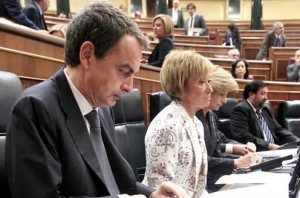
If Spain’s Socialists manage to engineer an incredible turnaround in the polls and win the 2012 general election, the chances are they will look back at October 21 of this year as the day when the comeback started.
Such a result still looks a long way off, but José Luis Rodríguez Zapatero’s biggest Cabinet reshuffle of his six years in power was one of the boldest moves of his career and it looks certain to invigorate a party that was limping along under a leadership with shrinking capital.
Zapatero’s seventh reshuffle sees six ministers depart, four new ones arrive, with two changing portfolios and two ministries scrapped altogether.
While the scale of the move is noteworthy, the details of the reshuffle are telling. One of the most obvious aims of it is to reach out to disenchanted Socialist voters, who by the spring of 2012 might have been tempted to vote for the more radical United Left (IU) or simply stay at home. The new environment minister, Rosa Aguilar, is a former IU mayor of Córdoba and her appointment gives the Cabinet a more attractive profile for leftist voters.
Valeriano Gómez, who takes on the thankless task of labour minister, also comes from the left of the political spectrum, having been a former senior figure in the UGT union. In fact, his labour union DNA still seems very much alive, given that he took part in the September 29 general strike against government labour reform and economic policy. This, critics point out, is hardly the ideal background for someone who will be responsible for implementing that same labour law. That said, he might be able to help repair some of the damage the strike inflicted on the government’s relationship with the unions.
But if one person stands out more than any other after this reshuffle, it is Interior Minister Alfredo Pérez Rubalcaba. While maintaining the interior portfolio, he replaces María Teresa Fernández de la Vega as deputy prime minister.
This reflects Rubalcaba’s ability to remain popular with voters despite being a key Cabinet figure since 2006 and having served in the latter days of the ailing Felipe González administration between 1993 and 1996. His no-nonsense, low-key style, success in keeping up police and judicial pressure on ETA and distance from economic issues have meant he is Spain’s most popular Socialist politician.
He is now also the most powerful one after Zapatero. His new, beefed-up role also suggests that he is the most likely replacement for Zapatero should the prime minister not run for re-election in 2012. With that decision probably delayed until after next spring’s local elections, Rubalcaba will be very much in the spotlight until then.
No room for idealism
This series of sackings and appointments also shows the more pragmatic, gritty side of Zapatero that the economic slump has made so evident. There is no room for the idealistic policy of full equality that he introduced to Moncloa Palace, with more men than women now in the Cabinet for the first time since he took power in 2004; the Equality Ministry was one of the two victims of the government’s austerity-driven scaling down (the Housing Ministry was the other scrapped department).
“We need a renewed and politically strengthened government,” Zapatero said on unveiling his new team. “This will be a government of reforms, of definitive recovery for the economy and employment.”
Those are undoubtedly priorities for the prime minister, but the biggest one is the 2012 vote. This reshuffle, delayed from June and only decided upon, Zapatero says, three days before its announcement, injects his administration with a shot of energy, but it might end up being too late to become the historic move its architect hopes it will be.
Leave a Reply
You must be logged in to post a comment.